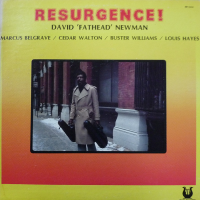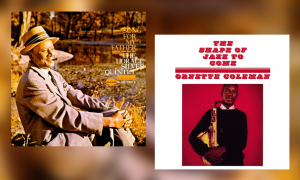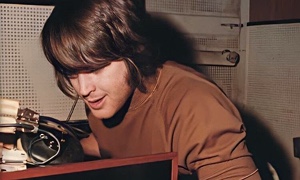Home » Jazz Articles » Building a Jazz Library » Muse Records: Ten Smoking Hot Albums
Muse Records: Ten Smoking Hot Albums

Let’s put ‘produced by’ into perspective. Most jazz artists are self-produced really. Woody Shaw produced Woody Shaw. Sonny Stitt produced Sonny Stitt. You didn’t tell those guys what to do. What could I tell David ‘Fathead’ Newman? Nothing. But what I would do was provide guidance to some of the younger guys and give them direction. That’s the real extent of the producing I was involved in.
—Joe Fields
This relative obscurity is partly explained by the diversity of Muse's catalogue, which spanned hard bop, post bop, politically informed spiritual jazz, straight-ahead, vocal jazz, Latin jazz, avant-garde, jazz rock and funk-informed jazz and R&B hybrids, and so was resistant to the affixing of the sort of simplistic identity beloved by journalists.
Fields recognised the fact in an interview he gave in 2014. "I'm music-orientated but also sales-orientated," said Fields. "If you are an ECM label and you are making ECM music, you are catering strictly for those people. But if you are Muse type label, you might do a Houston Person album that is in one direction and then do a Carlos Garnett that is way off into another direction. It was always important for me to find a balance and to cater to the many different tastes in jazz." Fields added: "You can't be all things to all people, but you can make everything of quality in its own particular groove."
Born in New Jersey in 1929, Fields set up Muse in 1972, having begun his career as a salesman for Columbia in the 1950s. In the 1960s he worked for Verve under Creed Taylor, Prestige under Bob Weinstock, R&B label Sue, and, at the end of the decade set up the Cobblestone jazz label, a subsidiary of Buddah. Fields' founding partner in Muse was the producer Don Schlitten, who left six years later.
Weinstock was a strong influence on Fields. "Bob was a guy who was really into the music and was really early onto the scene," he said in 2014. "You know he had Miles and all those people really early on. I saw how he ran his organisation and in the back of my mind I thought if he can do it so can I."
One of Weinstock's characteristics adopted by Fields was a hands-off approach to producing. "Let's put 'produced by' into perspective," said Fields. "Most jazz artists are self- produced really. Woody Shaw produced Woody Shaw. Sonny Stitt produced Sonny Stitt. You didn't tell those guys what to do. What could I tell David 'Fathead' Newman? Nothing. But what I would do was provide guidance to some of the younger guys and give them direction. That's the real extent of the producing I was involved in."
Fields sold Muse in 1996, when he set up HighNote and Savant labels with his son, Barney Fields. He passed in 2017, aged 88 years.
FOLLOW YOUR MUSE: TEN KEY ALBUMS 1972 -1993
 Roy Brooks
Roy Brooks The Free Slave
1972
Drummer, composer and occasional bandleader Roy Brooks was one of the leading lights of the politicised strand of spiritual jazz associated with the Muse, Strata- East and Impulse! labels in the 1970s. But he is in 2020 barely remembered in the wider jazz community. Partly this is because Brooks spent much of his career in his native Detroit rather than New York; partly it is because mental health issues periodically interrupted his career. Recorded live in Baltimore, The Free Slave is Brooks' chef d'oeuvre, and its outrageously funky title-track establishes a visceral ambiance which is maintained throughout the forty-six minute, four-track album, which has a two-horn frontline of trumpeter Woody Shaw and tenor saxophonist George Coleman. Though his inquisitor is bland and ill informed, Brooks connoisseurs will enjoy his extended radio interview included on the Charles Mingus five-disc boxset Mingus: Jazz In Detroit (Barely Breaking Even, 2018), recorded during a Mingus residency at the city's Strata Concert Gallery in 1973. The Free Slave is up there in the spiritual jazz honour-roll alongside alto saxophonist Shamek Farrar's masterpiece, First Impressions (Strata-East, 1974).
 Chick Corea
Chick Corea Bliss!
1973
A many splendored record, Bliss! was originally released under drummer Pete LaRoca's name on the Douglas label as Turkish Women At The Bath in 1967. On it, LaRoca, who wrote all the material, is the nominal leader of a quartet including Chick Corea on piano, John Gilmore on tenor saxophone and Walter Booker on bass. Reissued by Muse under Corea's name, it was retitled after the track which Corea performs as a duet with Booker. It was recorded the year before Corea joined the Miles Davis band and it is easy to see why Davis recruited him: Corea's trippy, often spectral lines are the very stuff of In A Silent Way (Columbia, 1969), and there are times, particularly on the title track, when one imagines he is playing a Fender Rhodes even though he is not. Withdrawn by Muse following complaints by LaRoca, Bliss! has since been released, or rather pirated, by numerous labels. Fittingly perhaps, for producer Alan Douglas, who released albums of dubious provenance featuring Jimi Hendrix, John McLaughlin and the Last Poets, was a buccaneer whose passion for music led him to sail close to the wind on more than one occasion.
 Carlos Garnett
Carlos Garnett Journey To Enlightenment
1974
Another electric era Miles Davis sideman, alto saxophonist Carlos Garnett was in the band which recorded Davis' still divisive On The Corner (Columbia, 1972). On Journey To Enlightment, his own name debut, Garnett is joined by fellow Davis alumnus Reggie Lucas on guitar, Hubert Eaves on keyboards, Howard 'KingFish' Franklin on drums, Sir Charles Pulliam and Neil Clarke on percussion, and Ayodele Jenkins on vocals. Less relentlessly intense than On The Corner, the music is cut from the same cloth: a steamy mix of jazz and funk, spiced with Caribbean elements reflecting Garnett's Panamanian heritage. By 1974, Garnett's jazz credentials were impeccable, including in addition to Davis, Freddie Hubbard, Art Blakey, Charles Mingus, Pharoah Sanders and Andrew Hill—but he could also gratifyingly channel Junior Walker & the All Stars when the fancy took him.
 Lester Bowie
Lester Bowie Fast Last!
1974
For pure absurdist brilliance, nothing trumpeter Lester Bowie recorded ever topped the title track of his album The Great Pretender (ECM, 1981), but "Hello Dolly" on Fast Last! comes close. Was Bowie making fun of Louis Armstrong's version of ten years previously? Maybe a little, but Bowie had so much respect for Armstrong that any such exercise would be affectionate. In any case, Bowie uses the tune primarily as a vehicle for a range of effects—half valving, growls, bent notes and broad vibrato— all of which Armstrong had pioneered decades before. Ornette Coleman's "Lonely Woman," which opens the album, is given a similarly radical reading which plumbs the melancholia beneath Coleman's deceptively pretty melody. Elsewhere on the album Bowie moves through his customary odyssey of jazz history aided and abetted by brother Joseph Bowie on trombone, Julius Hemphill on alto saxophone and John Stubblefield on tenor saxophone. Hemphill contributes two tracks including the sublime "Banana Whistle," which combines echoes of contemporary blaxploitation-soundtracks with out-there free jazz. John Hicks is on piano, Cecil McBee on bass and Bowie's Art Ensemble Of Chicago colleague Phillip Wilson on drums.
 Woody Shaw
Woody Shaw The Moontrane
1975
Like so much of trumpeter Woody Shaw's legacy, The Moontrane has long been off catalogue. It was last reissued (on CD) in the late 1990s. It is one of Shaw's best realised albums. His frontline partners are Azar Lawrence on tenor and soprano saxophones and Steve Turre on trombone, and the rhythm section is Onaje Allan Gumbs on keyboards, Cecil McBee and Buster Williams taking turns on bass, Victor Lewis on drums, and Tony Waters and Guilherme Franco on percussion. The material includes Shaw's much-covered title track, which he first recorded with organist Larry Young on Young's Unity (Blue Note, 1966). All five tracks are in-band originals and include Lawrence's "Tapscott's Blues," a spirited tribute to pianist and composer Horace Tapscott, Los Angeles community activist and leader of the Pan Afrikan Peoples Arkestra.
 Clifford Jordan
Clifford Jordan Inward Fire
1978
Like many jazz musicians who began their careers in the early 1950s, in order to pay the rent tenor saxophonist Clifford Jordan was obliged to shake, rattle and roll for striptease and burlesque dancers and, on a good night, with R&B bands. Interviewed by David H. Rosenthal for his authoritative survey Hard Bop: Jazz & Black Music 1955- -1965 (Oxford University Press, 1992), Jordan wryly remarked: "You try to clean house once in a while, but there's a lot of stuff that keeps coming out." In Jordan's case, the bump and grind was tempered by flashes of his formative influence Lester Young. Jordan's straight-ahead hard bop is well captured on The Adventurer (Muse, 1980), where he leads a quartet featuring Tommy Flanagan on piano. Inward Fire is a more experimentally inclined affair made with a tentet which includes Dizzy Reece on trumpet, Pat Patrick on tenor saxophone and flute, Howard Johnson on tuba, Muhal Richard Abrams on piano and, on two tracks, vocals. Among the standouts is Jordan's soulful seven-minute salute, "Buddy Bolden's Call."
 David "Fathead" Newman
David "Fathead" Newman Resurgence!
1981
David "Fathead" Newman was the featured tenor saxophonist in Ray Charles' bands from 1954—1964 and the downhome visceralism that Charles favoured remained a feature of Newman's style during his subsequent career in bands led by Hank Crawford, B.B. King, Junior Mance and Jimmy McGriff. But Newman could also play convincing hard-bop, as he does on this solid sextet set with fellow Ray Charles alumnus Marcus Belgrave on trumpet, Ted Dunbar on guitar, Cedar Walton on acoustic and electric piano, Buster Williams on bass and Louis Hayes on drums. To hear Newman in undiluted R&B mode, the best album is Ray Charles' live masterpiece, In Person (Atlantic, 1960), recorded in Atlanta (and also featuring Belgrave).
 James Spaulding
James Spaulding Brilliant Corners
1989
James Spaulding was a mainstay of Blue Note hard-bop releases in the 1960s—adding his fierce, driving alto saxophone and lyrical flute to albums by Freddie Hubbard, Hank Mobley, Lee Morgan, Duke Pearson, Wayne Shorter and Horace Silver among others—before morphing towards spiritual jazz on the Strata-East and Flying Dutchman labels in the 1970s with leaders such as trumpeter Charles Tolliver and vocalist Leon Thomas. He made relatively few albums under his own name and Brilliant Corners is arguably his best. As the title suggests, it is a Thelonious Monk-centric set: all but two of the eight pieces (Bud Powell's "Down With It" and Miles Davis' "Little Willie Leaps") were written by Monk. A superb band features Wallace Roney on trumpet, Mulgrew Miller on piano, Ron Carter on bass and Kenny Washington on drums.
 Larry Coryell
Larry Coryell Shining Hour
1990
Exclusively associated in some quarters with jazz rock, which he co-pioneered in the late 1960s, guitarist Larry Coryell was an equally compelling soloist in post- bop contexts. He made several straight-ahead albums for Muse in the late 1980s, before biting the fusion bullet and making a series of forgettable albums for CTI. Shining Hour has Coryell leading a quartet comprising pianist Kenny Barron, bassist Buster Williams and drummer Marvin Smith. The material is split between Great American Songbook standards and jazz standards, the latter including Wayne Shorter's "Nefertiti" and Herbie Hancock's "The Sorcerer." Coryell goes easier on the pedals than he does in full-on jazz-rock mode but otherwise sticks to his regular, fleet-fingered soloing template, admirably accompanied by Barron, Williams and Smith. (Six Degrees of Separation note: Williams subbed for Ron Carter on one of the sessions for Miles Davis' 1967 Columbia album Sorcerer but on an unused take of "Limbo" rather than the title track).
 Wallace Roney
Wallace Roney Crunchin'
1993
Dismissed by some people as a Miles Davis clone when he debuted on Muse with Verses (1987), by 1993, half a dozen albums for the label later, Wallace Roney had unmistakably become his own man. That Roney's sound retained recognisable traces of Davis is hardly surprising, for he studied with Davis from 1985 until Davis' passing in 1991—the only trumpeter so favoured. On Crunchin', Roney shares the frontline with alto saxophonist Antonio Hart and the rhythm section consists of pianist Geri Allen (who Roney would marry two years later), bassist Ron Carter and drummer Kenny Washington. By now secure enough in his own identity to inhabit material associated with his mentor, Roney references bop-and electric-era Davis with Dizzy Gillespie's "Woody 'n' You" and Davis' "Swing Spring," and Jule Styne's "Time After Time." There are two Thelonious Monk tunes ("We See" and "Misterioso") and three beautiful Great American Songbook covers, notably including Bob Haggart's "What's New." Roney was in the main an interpreter of others' tunes throughout his life, another (if less frequently remarked on) similarity with Davis.
Photo: Wallace Roney
Tags
Building a Jazz Library
Chris May
Creed Taylor
Bob Weinstock
Roy Brooks
Woody Shaw
George Coleman
Charles Mingus
Shamek Farrar
Pete LaRoca
Chick Corea
John Gilmore
Walter Booker
Miles Davis
Jimi Hendrix
john mclaughlin
Last Poets
Carlos Garnett
Reggie Lucas
Hubert Eaves
Howard King
Charles Pulliam
Neil Clarke
Freddie Hubbard
Art Blakey
Pharoah Sanders
Andrew Hill
Junior Walker
Lester Bowie
Louis Armstrong
Ornette Coleman
Joseph Bowie
Julius Hemphill
John Stubblefield
John Hicks
cecil mcbee
Art Ensemble of Chicago
Phillip Wilson
Azar Lawrence
Steve Turre
Onaje Allan Gumbs
Buster Williams
Victor Lewis
Tony Waters
Guilherme Franco
Larry Young
Horace Tapscott
Clifford Jordan
Lester Young
Tommy Flanagan
Dizzy Reece
Pat Patrick
Howard Johnson
Muhal Richard Abrams
David Fathead Newman
Ray Charles
Hank Crawford
B.B. King
Junior Mance
Jimmy McGriff
Marcus Belgrave
Ted Dunbar
Cedar Walton
Louis Hayes
James Spaulding
Hank Mobley
lee morgan
Duke Pearson
Wayne Shorter
Horace Silver
Charles Tolliver
Leon Thomas
Thelonious Monk
Bud Powell
Wallace Roney
Mulgrew Miller
Ron Carter
Kenny Washington
Larry Coryell
Kenny Barron
Marvin Smith
Herbie Hancock
Antonio Hart
Geri Allen
Dizzy Gillespie
PREVIOUS / NEXT
Support All About Jazz
 All About Jazz has been a pillar of jazz since 1995, championing it as an art form and, more importantly, supporting the musicians who make it. Our enduring commitment has made "AAJ" one of the most culturally important websites of its kind, read by hundreds of thousands of fans, musicians and industry figures every month.
All About Jazz has been a pillar of jazz since 1995, championing it as an art form and, more importantly, supporting the musicians who make it. Our enduring commitment has made "AAJ" one of the most culturally important websites of its kind, read by hundreds of thousands of fans, musicians and industry figures every month.




















